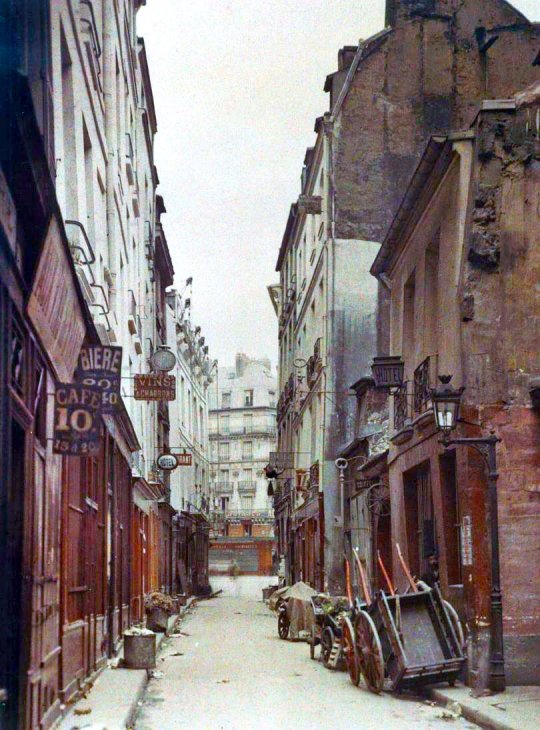Text
is YOUR Blorbo a wertherino?

If they:
are a beautiful young man with a somber/serious/melancholic disposition;
have a job that they hate;
are discriminated against at some point for their social status;
are the narrator of the media they appear in;
are being pressured by their families to do something they don’t want to do;
are desperately in love with an unattainable person, who may or may not love him back;
love that person to the point of harming themselves/others if they cannot have them;
are extremely jealous/possessive;
do weird stalky things to their object of desire, like following them home or spying on them;
view their object of desire as the culmination of all virtue and goodness combined in one person;
give their beloved a kind of “surrogate kiss”, like kissing them through a veil or having a canary peck the beloved’s lips and then theirs;
have the seasons/nature represent the internal state of their emotions;
like sending long winding letters to their one friend whom they dump all their feelings on about their ills and sufferings.
Then they might be a wertherino!
If five or more apply:
Be sure to keep them away from pistols, knives, scissors, poison, and student rebellions;
Be sure that their beloved does not get married to another, sail away to England, cheat on them with their best friend, etc. if it can be avoided;
Provide him a bench under a tree where he can read Homer and watch children play in peace;
Do NOT let him go dancing, drinking, gambling, or such unless under close supervision.
If your wertherino still succumbs, remember that laborers will carry his coffin, and no priest will attend his funeral.
#telling myself increasingly unconvincingly that i'm reblogging to main rather than my general-use sideblog Because Romanticism#and not because waving this post in front of the spn samgirls over there would be an unprovoked act of violence against OP
121 notes
·
View notes
Text

Paul Gavarni, L'Artiste: Far-Niente ("the artist doing nothing"), 1835.
306 notes
·
View notes
Text
"you wouldn't last an hour in the asylum where they raised me" meme and the picture is just fanart of fanon les amis de l'abc circa 2013
400 notes
·
View notes
Text
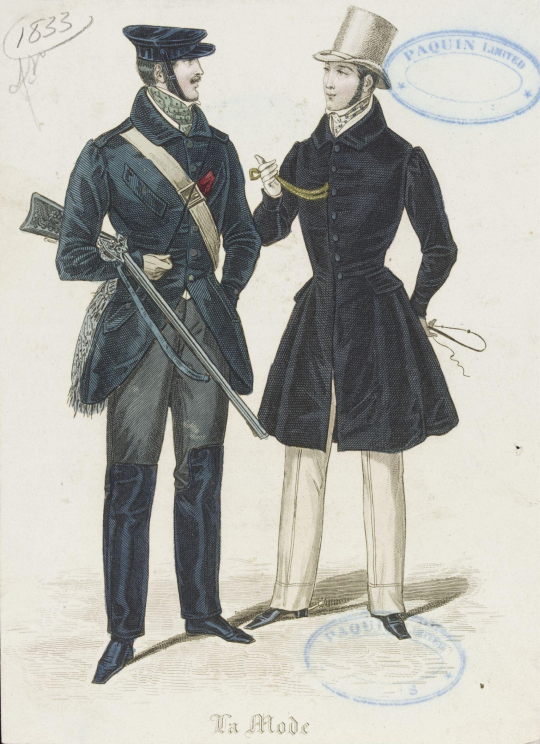


Looks of 1833
Hunting dress and black frock coat, day dress with brown frock coat, and evening dress with dressing gown.
87 notes
·
View notes
Photo
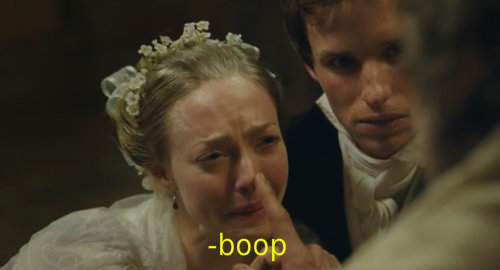
The Real Les Mis Captions
427K notes
·
View notes
Text
if you're a random stranger and I just followed and then immediately unfollowed your blog, apologies, I pinky-swear I'm not engaging in some twisted game of psychological warfare, the Tumblr app just makes it WAY too easy to fat-finger the Follow button when the action I really meant to take was
get booped, idiot <3
#i've done this to like three or four people since the madness started it's mortifying#tumblr why do you even HAVE follow buttons all over the dash. who tf is out here subscribing to entire blogs sight unseen based on One Post#that's like dashboard russian roulette with only one chamber empty and the rest loaded with the internet's finest assortment of Not For Me
23 notes
·
View notes
Text
I’m gonna hopefully predict the future right now because I just had such an idea. The best Les Mis adaptation of the 2020s will be an album released by a goth band. Each song will be at least 5 minutes long and the Waterloo digression alone gets about 7 minutes.
178 notes
·
View notes
Text

Hey guys so I'm reading a 20-year-old comedy history of the French Revolution (Vive la Revolution by Mark Steel, published in 2003), and I just came across this...prescient passage...
(side note, tumblr user @creekfiend recommended this book to me literally 14 years ago, which I know because the receipt from when I bought it was still tucked inside, and I have only just now gotten around to reading it)
160 notes
·
View notes
Text
I have just learnt that there is every year, in Montreuil-sur-Mer, a 'son et lumière' performance to pay tribute to Hugo's work and where the whole Les Misérables story is put on. It's 1h30 away from here. They are looking for extras - they need them every year and the performance has been a tradition for 25 years (minus covid and weather aléas). Each performance involves around 500 actors. Look at this!

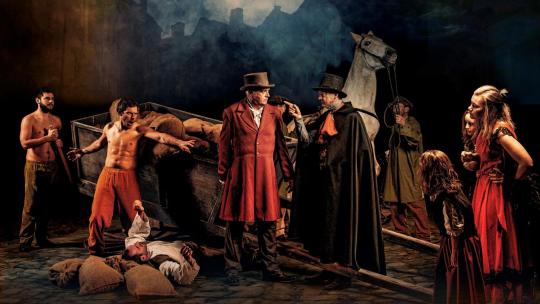

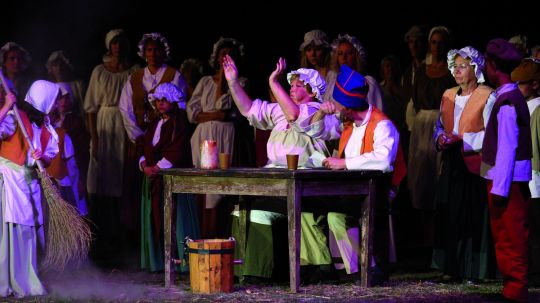

174 notes
·
View notes
Text
A Guide to Historically Accurate Regency-Era Names

I recently received a message from a historical romance writer asking if I knew any good resources for finding historically accurate Regency-era names for their characters.
Not knowing any off the top of my head, I dug around online a bit and found there really isn’t much out there. The vast majority of search results were Buzzfeed-style listicles which range from accurate-adjacent to really, really, really bad.
I did find a few blog posts with fairly decent name lists, but noticed that even these have very little indication as to each name’s relative popularity as those statistical breakdowns really don't exist.
I began writing up a response with this information, but then I (being a research addict who was currently snowed in after a blizzard) thought hey - if there aren’t any good resources out there why not make one myself?
As I lacked any compiled data to work from, I had to do my own data wrangling on this project. Due to this fact, I limited the scope to what I thought would be the most useful for writers who focus on this era, namely - people of a marriageable age living in the wealthiest areas of London.
So with this in mind - I went through period records and compiled the names of 25,000 couples who were married in the City of Westminster (which includes Mayfair, St. James and Hyde Park) between 1804 to 1821.
So let’s see what all that data tells us…
To begin - I think it’s hard for us in the modern world with our wide and varied abundance of first names to conceive of just how POPULAR popular names of the past were.
If you were to take a modern sample of 25-year-old (born in 1998) American women, the most common name would be Emily with 1.35% of the total population. If you were to add the next four most popular names (Hannah, Samantha, Sarah and Ashley) these top five names would bring you to 5.5% of the total population. (source: Social Security Administration)
If you were to do the same survey in Regency London - the most common name would be Mary with 19.2% of the population. Add the next four most popular names (Elizabeth, Ann, Sarah and Jane) and with just 5 names you would have covered 62% of all women.
To hit 62% of the population in the modern survey it would take the top 400 names.
The top five Regency men’s names (John, William, Thomas, James and George) have nearly identical statistics as the women’s names.
I struggled for the better part of a week with how to present my findings, as a big list in alphabetical order really fails to get across the popularity factor and also isn’t the most tumblr-compatible format. And then my YouTube homepage recommended a random video of someone ranking all the books they’d read last year - and so I present…
The Regency Name Popularity Tier List
The Tiers
S+ - 10% of the population or greater. There is no modern equivalent to this level of popularity. 52% of the population had one of these 7 names.
S - 2-10%. There is still no modern equivalent to this level of popularity. Names in this percentage range in the past have included Mary and William in the 1880s and Jennifer in the late 1970s (topped out at 4%).
A - 1-2%. The top five modern names usually fall in this range. Kids with these names would probably include their last initial in class to avoid confusion. (1998 examples: Emily, Sarah, Ashley, Michael, Christopher, Brandon.)
B - .3-1%. Very common names. Would fall in the top 50 modern names. You would most likely know at least 1 person with these names. (1998 examples: Jessica, Megan, Allison, Justin, Ryan, Eric)
C - .17-.3%. Common names. Would fall in the modern top 100. You would probably know someone with these names, or at least know of them. (1998 examples: Chloe, Grace, Vanessa, Sean, Spencer, Seth)
D - .06-.17%. Less common names. In the modern top 250. You may not personally know someone with these names, but you’re aware of them. (1998 examples: Faith, Cassidy, Summer, Griffin, Dustin, Colby)
E - .02-.06%. Uncommon names. You’re aware these are names, but they are not common. Unusual enough they may be remarked upon. (1998 examples: Calista, Skye, Precious, Fabian, Justice, Lorenzo)
F - .01-.02%. Rare names. You may have heard of these names, but you probably don’t know anyone with one. Extremely unusual, and would likely be remarked upon. (1998 examples: Emerald, Lourdes, Serenity, Dario, Tavian, Adonis)
G - Very rare names. There are only a handful of people with these names in the entire country. You’ve never met anyone with this name.
H - Virtually non-existent. Names that theoretically could have existed in the Regency period (their original source pre-dates the early 19th century) but I found fewer than five (and often no) period examples of them being used in Regency England. (Example names taken from romance novels and online Regency name lists.)
Just to once again reinforce how POPULAR popular names were before we get to the tier lists - statistically, in a ballroom of 100 people in Regency London: 80 would have names from tiers S+/S. An additional 15 people would have names from tiers A/B and C. 4 of the remaining 5 would have names from D/E. Only one would have a name from below tier E.
Women's Names
S+ Mary, Elizabeth, Ann, Sarah
S - Jane, Mary Ann+, Hannah, Susannah, Margaret, Catherine, Martha, Charlotte, Maria
A - Frances, Harriet, Sophia, Eleanor, Rebecca
B - Alice, Amelia, Bridget~, Caroline, Eliza, Esther, Isabella, Louisa, Lucy, Lydia, Phoebe, Rachel, Susan
C - Ellen, Fanny*, Grace, Henrietta, Hester, Jemima, Matilda, Priscilla
D - Abigail, Agnes, Amy, Augusta, Barbara, Betsy*, Betty*, Cecilia, Christiana, Clarissa, Deborah, Diana, Dinah, Dorothy, Emily, Emma, Georgiana, Helen, Janet^, Joanna, Johanna, Judith, Julia, Kezia, Kitty*, Letitia, Nancy*, Ruth, Winifred>
E - Arabella, Celia, Charity, Clara, Cordelia, Dorcas, Eve, Georgina, Honor, Honora, Jennet^, Jessie*^, Joan, Joyce, Juliana, Juliet, Lavinia, Leah, Margery, Marian, Marianne, Marie, Mercy, Miriam, Naomi, Patience, Penelope, Philadelphia, Phillis, Prudence, Rhoda, Rosanna, Rose, Rosetta, Rosina, Sabina, Selina, Sylvia, Theodosia, Theresa
F - (selected) Alicia, Bethia, Euphemia, Frederica, Helena, Leonora, Mariana, Millicent, Mirah, Olivia, Philippa, Rosamund, Sybella, Tabitha, Temperance, Theophila, Thomasin, Tryphena, Ursula, Virtue, Wilhelmina
G - (selected) Adelaide, Alethia, Angelina, Cassandra, Cherry, Constance, Delilah, Dorinda, Drusilla, Eva, Happy, Jessica, Josephine, Laura, Minerva, Octavia, Parthenia, Theodora, Violet, Zipporah
H - Alberta, Alexandra, Amber, Ashley, Calliope, Calpurnia, Chloe, Cressida, Cynthia, Daisy, Daphne, Elaine, Eloise, Estella, Lilian, Lilias, Francesca, Gabriella, Genevieve, Gwendoline, Hermione, Hyacinth, Inez, Iris, Kathleen, Madeline, Maude, Melody, Portia, Seabright, Seraphina, Sienna, Verity
Men's Names
S+ John, William, Thomas
S - James, George, Joseph, Richard, Robert, Charles, Henry, Edward, Samuel
A - Benjamin, (Mother’s/Grandmother’s maiden name used as first name)#
B - Alexander^, Andrew, Daniel, David, Edmund, Francis, Frederick, Isaac, Matthew, Michael, Patrick~, Peter, Philip, Stephen, Timothy
C - Abraham, Anthony, Christopher, Hugh>, Jeremiah, Jonathan, Nathaniel, Walter
D - Adam, Arthur, Bartholomew, Cornelius, Dennis, Evan>, Jacob, Job, Josiah, Joshua, Lawrence, Lewis, Luke, Mark, Martin, Moses, Nicholas, Owen>, Paul, Ralph, Simon
E - Aaron, Alfred, Allen, Ambrose, Amos, Archibald, Augustin, Augustus, Barnard, Barney, Bernard, Bryan, Caleb, Christian, Clement, Colin, Duncan^, Ebenezer, Edwin, Emanuel, Felix, Gabriel, Gerard, Gilbert, Giles, Griffith, Harry*, Herbert, Humphrey, Israel, Jabez, Jesse, Joel, Jonas, Lancelot, Matthias, Maurice, Miles, Oliver, Rees, Reuben, Roger, Rowland, Solomon, Theophilus, Valentine, Zachariah
F - (selected) Abel, Barnabus, Benedict, Connor, Elijah, Ernest, Gideon, Godfrey, Gregory, Hector, Horace, Horatio, Isaiah, Jasper, Levi, Marmaduke, Noah, Percival, Shadrach, Vincent
G - (selected) Albion, Darius, Christmas, Cleophas, Enoch, Ethelbert, Gavin, Griffin, Hercules, Hugo, Innocent, Justin, Maximilian, Methuselah, Peregrine, Phineas, Roland, Sebastian, Sylvester, Theodore, Titus, Zephaniah
H - Albinus, Americus, Cassian, Dominic, Eric, Milo, Rollo, Trevor, Tristan, Waldo, Xavier
& Men were sometimes given a family surname (most often their mother's or grandmother's maiden name) as their first name - the most famous example of this being Fitzwilliam Darcy. If you were to combine all surname-based first names as a single 'name' this is where the practice would rank.
*Rank as a given name, not a nickname
+If you count Mary Ann as a separate name from Mary - Mary would remain in S+ even without the Mary Anns included
~Primarily used by people of Irish descent
^Primarily used by people of Scottish descent
>Primarily used by people of Welsh descent
I was going to continue on and write about why Regency-era first names were so uniform, discuss historically accurate surnames, nicknames, and include a little guide to finding 'unique' names that are still historically accurate - but this post is already very, very long, so that will have to wait for a later date.
If anyone has any questions/comments/clarifications in the meantime feel free to message me.
Methodology notes: All data is from marriage records covering six parishes in the City of Westminster between 1804 and 1821. The total sample size was 50,950 individuals.
I chose marriage records rather than births/baptisms as I wanted to focus on individuals who were adults during the Regency era rather than newborns. I think many people make the mistake when researching historical names by using baby name data for the year their story takes place rather than 20 to 30 years prior, and I wanted to avoid that. If you are writing a story that takes place in 1930 you don’t want to research the top names for 1930, you need to be looking at 1910 or earlier if you are naming adult characters.
I combined (for my own sanity) names that are pronounced identically but have minor spelling differences: i.e. the data for Catherine also includes Catharines and Katherines, Susannah includes Susannas, Phoebe includes Phebes, etc.
The compound 'Mother's/Grandmother's maiden name used as first name' designation is an educated guesstimate based on what I recognized as known surnames, as I do not hate myself enough to go through 25,000+ individuals and confirm their mother's maiden names. So if the tally includes any individuals who just happened to be named Fitzroy/Hastings/Townsend/etc. because their parents liked the sound of it and not due to any familial relations - my bad.
I did a small comparative survey of 5,000 individuals in several rural communities in Rutland and Staffordshire (chosen because they had the cleanest data I could find and I was lazy) to see if there were any significant differences between urban and rural naming practices and found the results to be very similar. The most noticeable difference I observed was that the S+ tier names were even MORE popular in rural areas than in London. In Rutland between 1810 and 1820 Elizabeths comprised 21.4% of all brides vs. 15.3% in the London survey. All other S+ names also saw increases of between 1% and 6%. I also observed that the rural communities I surveyed saw a small, but noticeable and fairly consistent, increase in the use of names with Biblical origins.
Sources of the records I used for my survey:
Ancestry.com. England & Wales Marriages, 1538-1988 [database on-line].
Ancestry.com. Westminster, London, England, Church of England Marriages and Banns, 1754-1935 [database on-line].
10K notes
·
View notes
Text
More Czech illustrations to Les Mis

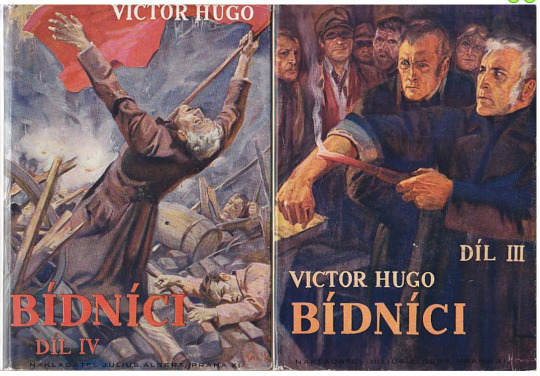
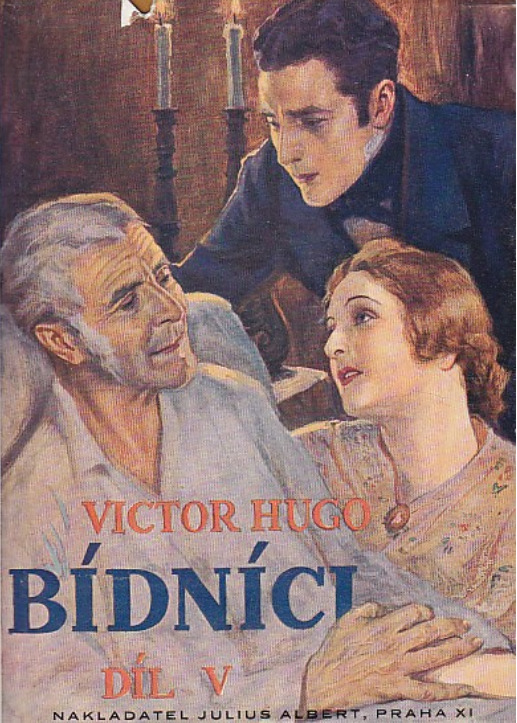
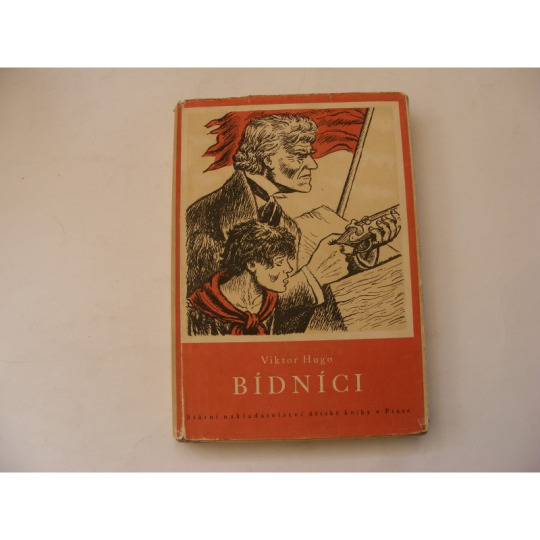
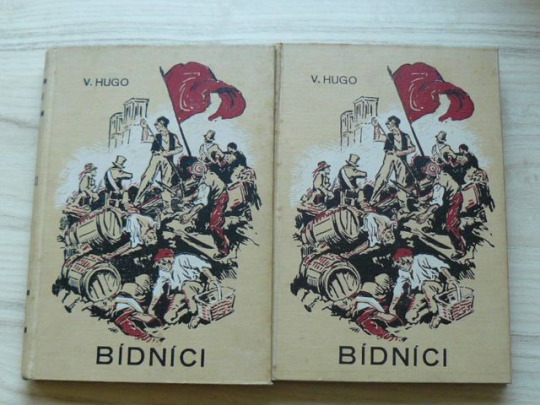
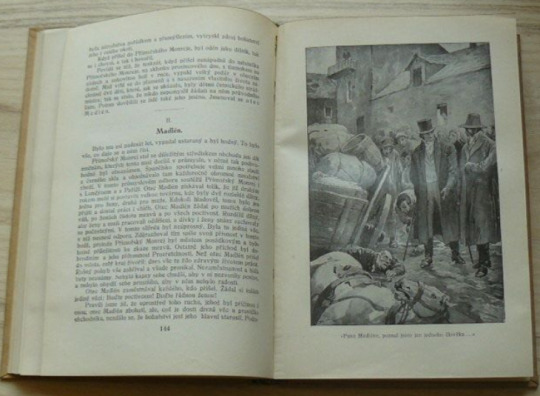

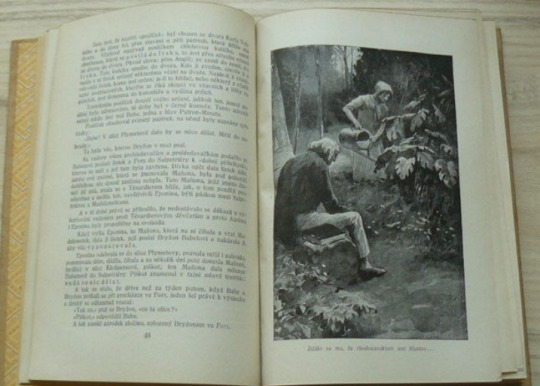


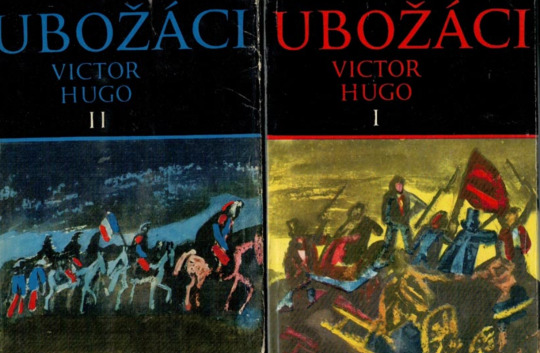
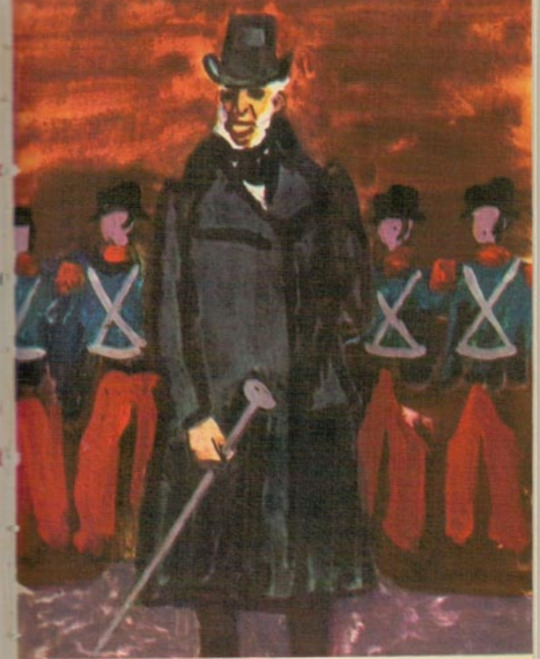

208 notes
·
View notes
Text

Louis Daguerre • Paris, 1838
The first photograph of a human being. The exposure time for the image was around seven minutes, and although the street would have been busy with traffic and pedestrians, it appears deserted.
Everything moving was too fast to register on the plate, the only exception is the man at the lower-left; he's getting is shoes shined.
508 notes
·
View notes
Text
#it's been ages but if 1982 is the grimy-ass robert hossein adaptation with lino ventura i remember it genuinely being one of my faves#however. i did not *quite* make that association in time to keep my finger from landing on the button for the batshit 2000 miniseries#its bizarreness is downright entertaining. it's camp. it's a masterpiece of star-studded stunt miscasting. i can still hear the soundtrack.#the 1998 one WISHES it could waste its big names as weirdly as setting a leather-clad john malkovich loose on bad french dialogue as javert#it may even deserve my vote over the 1982 one because by god is it memorable (derogatory) (yet grudgingly fond) many many years later
139 notes
·
View notes
Photo
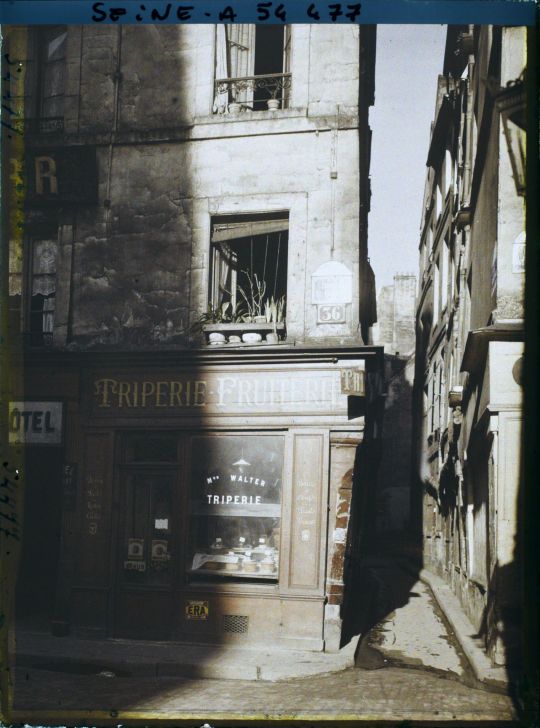
Auguste Léon - Paris (IVe arr.) L'angle des rues Brisemiche et Saint-Merri. 1928
30 notes
·
View notes
Text
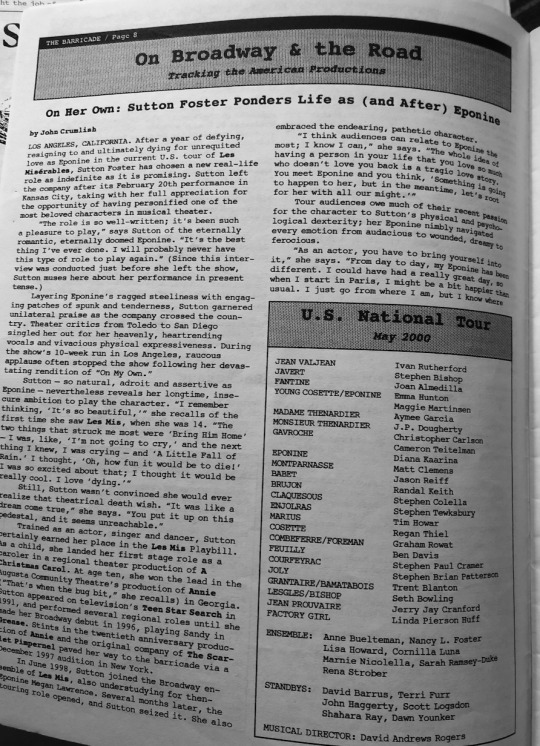
The Barricade, Summer 2000 issue (#27) — Interview with Sutton Foster
by John Crumlish
LOS ANGELES, CALIFORNIA. After a year of defying, resigning to and ultimately dying for unrequited love as Eponine in the current U.s. tour of Les Misérables, Sutton Foster has chosen a new real-life role as indefinite as it is promising. Sutton left the company after its February 20th performance in Kansas City, taking with her full appreciation for the opportunity of having personified one of the most beloved characters in musical theater.
"The role is so well-written; it's been such a pleasure to play," says Sutton of the eternally romantic, eternally doomed Eponine. "It's the best thing I've ever done. I will probably never have this type of role to play again." (Since this interview was conducted just before she left the show, Sutton muses here about her performance in present tense.)
Layering Eponine's ragged steeliness with engaging patches of spunk and tenderness, Sutton garnered unilateral praise as the company crossed the country. Theater critics from Toledo to San Diego singled her out for her heavenly, heartrending vocals and vivacious physical expressiveness. During the show's 10-week run in Los Angeles, raucous applause often stopped the show following her devastating rendition of "On My Own."
Sutton - so natural, adroit and assertive as Eponine - nevertheless reveals her longtime, insecure ambition to play the character. "I remember thinking, 'It's so beautiful, " she recalls of the first time she saw Les Mis, when she was 14. "The two things that struck me most were 'Bring Him Home' — I was, like, 'I'm not going to cry,' and the next thing I knew, I was crying — and 'A Little Fall of Rain.' I thought, 'Oh, how fun it would be to die!' I was so excited about that; I thought it would be really cool. I love 'dying.
Still, Sutton wasn't convinced she would ever realize that theatrical death wish. "It was like a dream come true," she says. "You put it up on this pedestal, and it seems unreachable."
Trained as an actor, singer and dancer, Sutton certainly earned her place in the Les Mis Playbill. As a child, she landed her first stage role as a caroler in a regional theater production of A Christmas Carol. At age ten, she won the lead in the Augusta Community Theatre's production of Annie ("That's when the bug bit," she recalls) in Georgia.
Sutton appeared on television's Teen Star Search in 1991, and performed several regional roles until she made her Broadway debut in 1996, playing Sandy in Grease. Stints in the twentieth anniversary production of Annie and the original company of The Scarlet Pimpernel paved her way to the barricade via a December 1997 audition in New York.
In June 1998, Sutton joined the Broadway ensemble of Les Mis, also understudying for then-Eponine Megan Lawrence. Several months later, the touring role opened, and Sutton seized it. She also embraced the endearing, pathetic character.
"I think audiences can relate to Eponine the most; I know I can, " she says. "The whole idea of having a person in your life that you love so much who doesn't love you back is a tragic love story. wow meet Eponine and you think, 'Something is going to happen to her, but in the meantime, let's root for her with all our might.'
Tour audiences owe much of their recent passion for the character to Sutton's physical and psychological dexterity; her Eponine nimbly navigated every emotion from audacious to wounded, dreamy to ferocious.
"As an actor, you have to bring yourself into it," she says. "From day to day, my Eponine has been different. I could have had a really great day, so when I start in Paris, I might be a bit happier than usual. I just go from where I am, but I know where to end up. I know where Eponine needs to be when "On My Own' starts. She is getting ready to die, but the journey there is different every night. That's what makes it fun."
Sutton even relied on her graceful lankiness — a physical blessing she once considered a hindrance in her pursuit of the role — to heighten the desperation of Eponine's unrequited love for Marius.
"I never thought I would play Eponine because I'm so tall," confesses the 5'9" brunette, "but I have that on my side. It has made me a little tougher. I use it as sort of a downfall — maybe if I were more petite, Marius would like me more."
She also enjoyed an easy rapport with real-life couple Tim Howar (Marius) and Regan Thiel (Cosette), who provided a convenient motivational device for Sutton as Eponine realizes during "A Heart Full of Love" that their union is one she can never divide.
"I look at Regan's curly blonde hair and think, 'Her hair is so beautiful; I don't have hair like that. Look at the way he looks at her; he doesn't look at me like that. Look at how she's making him smile,'" says Sutton. "They definitely have a connection. You end up using everything around you to support what you're trying to convey."
Eponine's silent confrontation with Cosette during the climax of "plumet Attack" afforded Sutton another situational metaphor through which to view her character's hopelessness in the face of pure love. "I think that's one of the best moments, especially between Regan and me," she says of the mystified gazes the characters share through the garden gates as an urgent crescendo of chords compels the act-one finale. "I am obviously aware of her presence in Paris because I brought Marius to her, but this is the first time in ten years that she remembers who I am.
Sutton also used the gates as a symbolic barrier that distinguishes the forlorn, love-starved Eponine from the sheltered, smitten Cosette. "It's the difference between where Cosette is and where I am, between rich and poor, between having Marius and not," Sutton explains. "It's completely black and white. It's a very important moment — the whole idea of me being like an animal, that I can't be in the real world, that I am not allowed to experience what they are experiencing."
Although Eponine basically sacrifices herself by relaying Marius' love letter to Cosette, Sutton says death brings the character both "A Little Fall of Rain" and a heap of joy. "I think Eponine knows she's doomed," she says. "At the same time, she has this glimmer of hope because she is naive, young and totally in love. To her, the happiest point is when she's dying, and there is so much irony in that."
Sutton's realistic portrayal of such an attractive yet tragic figure often elicited sympathies that extended beyond the stage. Such efforts to comfort her both amused and bewildered the fan-friendly Sutton. "People end up falling in love with the character, and when they meet me after the show, I'm like, 'I'm just a normal person,'" she says. "I want to reassure them that I'm okay. People want to get to know me and help me, and it's very funny."
This sympathetic blur presented a constant challenge to Sutton, not only at the stage door but on stage as well. She says the role of Eponine has been her most challenging to date. "It's a very hard role to sing," she says. "You have to allow yourself
to be weak yet incredibly strong. Eponine has all these opposites; she's incredibly tough yet incredibly vulnerable. That's a challenge to play, but at the same time, it's nice to go there — to let yourself be completely sensitive and vulnerable and scared. These are things that, as a human, you normally have to challenge with 'I am not vulner-able; I am strong and invincible.'"
Sutton found creative inspiration as well as diversion in the minor roles she assumed before the adult Eponine's first scene well into the first act.
Casting for Les Mis is unusual in that many of the principals (Eponine included) perform incognito in ensemble roles in the fields and factory, at the barricade and elsewhere. Sutton says she enjoyed portraying a factory worker indifferent to the unfairly discharged Fantine in "At the End of the Day" and a provocatively vulgar prostitute who quietly empathizes with the now corrupted Fantine in "Lovely Ladies." (Both scenes occur early in Act One, several scenes before the adult Eponine wanders into the Paris streets.) "They are fun scenes to play," Sutton explains. "I play it a bit cool until I play Eponine, but I still remain incredibly focused during the ensemble scenes."
Unlike other performers who take on secondary roles throughout the show, Sutton was not required to play any part after Eponine's death scene midway through the second act, until her beatific resurrection in the show's finale. Sutton welcomed her thirty- to forty-minute breather after so much emotional expenditure. "I have to shower because I'm covered in dirt, plus a little blood, " Sutton says of her post-"Rain" ritual. "I go and bug every-one. I also crochet; a lot of the girls do. Aymee Garcia (Madame Thénardier) and I taught a bunch of the girls how to crochet, so we are crazy crochet-Els now bring in a magazine or a book. One night, I ate a Krispy Kreme doughnut."
Sutton is just as efficient when considering the potential regret any Broadway performer might have for exchanging New York stability for a nomadic life on the road. "I like to take every opportunity as it comes," she explains. "If that means going on the road and sacrificing for a role that I truly believe in, then I'm ready."
To stay grounded as the show traveled, Sutton kept close to her cellular phone and laptop com-puter, and retained the lease on her New York apart-ment. She also maintained a consistent regimen in her free time. "I work out, go shopping, meet with friends, rest a lot, play on the computer, go for walks — very normal things people do on their day off," she says.
Logistical downsides manifested themselves at every new locale, but Sutton says the environmental variables offered psychological rejuvenation. "It's definitely a roamer's lifestyle; you're constantly in a different place and constantly starting over," she says. "You get to a different city and ask, 'Where's the grocery store? Where's the drugstore? Where's the gym? Where do I go to get a new book? But at the same time, it's cool because you get to start fresh. If you had a horrible week, the next city is like a brand new start."
While reactions to the road show were positive everywhere, Sutton sensed divergent energy levels among audiences in different cities. "Washington, D.C., was a lot more conservative than Los Angeles; I thought L.A. audiences would be very reserved and not whoop and holler, but they were the complete opposite," she says. "In Middle America, people are a bit dumbfounded during the show, but, by the end, they are going crazy. You get different feedback everywhere."
The L.A. stint of the tour yielded Sutton the chance to serve as one of the producers for the January 17 HIV/AIDS benefit Les Miscellaneous, which netted $300,000 for the Jeffrey Goodman Special Care Clinic at the Gay & Lesbian Center. As part of the festivities, Sutton also organized the impressive silent auction of Les Mis and other memorabilia. "It took two weeks for me to recuperate, but it was awesome," recalls Sutton modestly.
Although she is professionally breaking away from the road show, Sutton isn't likely to break her sentimental ties with her cast mates. "When you are on tour, you work and live with the same people, so they really become your family," says the 25-year-old actress. "I've become very close with several people in the cast who will be friends for life, and I've grown up a lot in this past year."
This personal epiphany helped steer Sutton towards the desire to spend time with her real family, and her decision to leave the show. "I have no immediate plans," she admits. "I need some time
to spend with my family and relatives. I'm going to spend some time with my brother [Hunter Foster, to performed in Martin Guerre last spring] in L.A., then venture back across the country and visit my family [in Orlando]. Then I will head back to New York, and hit the pavement again and try to get another job."
Sutton's resume is already replete with critically heralded performances, so her self-prescribed challenge is a professional fresh start upon her return to Broadway. "I would love to originate a new role, something that has never been done before in a new musical," she says. "I was in the original Broadway company of The Scarlet Pimpernel, and it's just so exciting to start a brand new work."
Talent, eagerness and faith led Sutton to her dream role once, but she is amenable to reprising her unique interpretation of Eponine, should destiny lead her back to Les mis again. "It's a pleasure to go on stage and do something you love, say words you truly believe in and sing lyrics that are so well-written and beautiful," Sutton says. "It will be hard to find another show as good. From now of I will compare everything to Les Mis, but at the same time, I am so glad I have had the opportunity to do it. I would love to done back and do it again sometime."
If and when that time arrives, Les Mis fans will surely welcome back Sutton — and her Eponine — with open hearts.
7 notes
·
View notes
